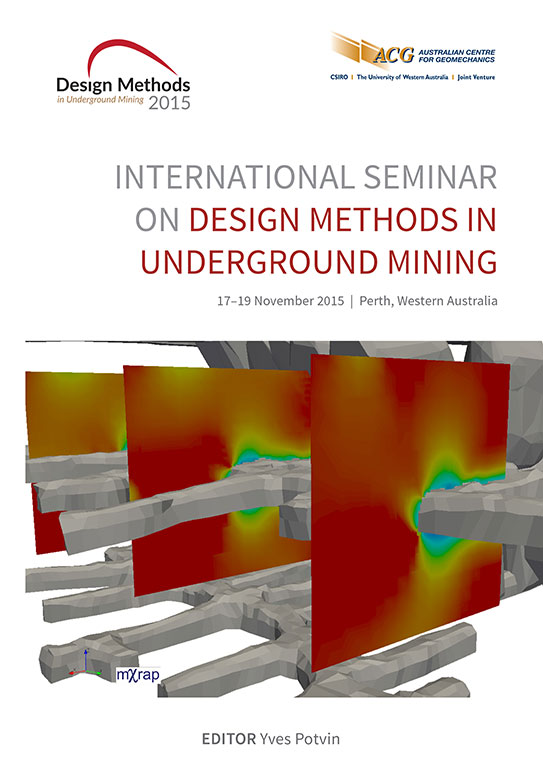Empirical ground support design of mine drives

|
Authors: Potvin, Y; Hadjigeorgiou, J |
DOI https://doi.org/10.36487/ACG_rep/1511_25_Potvin
Cite As:
Potvin, Y & Hadjigeorgiou, J 2015, 'Empirical ground support design of mine drives', in Y Potvin (ed.), Design Methods 2015: Proceedings of the International Seminar on Design Methods in Underground Mining, Australian Centre for Geomechanics, Perth, pp. 419-430, https://doi.org/10.36487/ACG_rep/1511_25_Potvin
Abstract:
The majority of Australian and Canadian underground hard rock mines rely on the Norwegian Method of Tunnelling ground support recommendations for preliminary design recommendations. This is the case during the pre-feasibility and feasibility stages where the Q-system is used to select the support standards. This is usually accompanied by a limit equilibrium wedge analysis and rules of thumb. It follows that as the mine advances more geomechanical data becomes available, including rock exposures that allow for an update of the ground conditions and revision of the recommendations. As the mine develops, the ground support standards evolve further. At any given time, the implemented ground support systems for the different ground conditions are documented and updated in the mine’s ground control management plan (GCMP). This paper addresses some of the limitations of the Norwegian Method of Tunnelling as a ground support design tool for mining excavations. The results of a comprehensive review of GCMPs, successfully implemented in Australian and Canadian hard rock underground mines, are the basis of newly developed empirical guidelines calibrated to mining conditions and ground support.
References:
Barton, N 1988, ‘Rock mass classification and tunnel reinforcement selection using the Q-system’, in L Kirkaldie (ed.), Rock classification systems for engineering purposes, American Society for Testing and Materials, Philadelphia, pp. 59-88.
Barton, N 1989, ‘Cavern design for Hong Kong rocks’, in AW Malone & PGD Whiteside (eds), Rock cavern – Hong Kong, The Australasian Institute of Mining and Metallurgy, Melbourne, pp. 179-202.
Barton, N, Lien, R & Lunde, J 1974, ‘Engineering classification of rock masses for design of tunnel support’, Rock Mechanics and Rock Engineering, vol. 6, no. 4, pp. 189-236.
Bieniawski, ZT 1976, ‘Rock mass classification in rock engineering’, in ZT Bieniawski (ed.), Exploration for Rock Engineering: Proceedings of the Symposium on Exploration for Rock Engineering, A.A. Balkema, Lisse, pp. 97-106.
Bieniawski, ZT 1989, Engineering rock mass classifications, John Wiley & Sons, New York, NY.
Grimstad, E & Barton, N 1993, ‘Updating the Q-system for NMT’, in C Kompen, SL Opsahl & SL Berg (eds), Proceedings of the International Symposium on Sprayed Concrete, Norwegian Concrete Association, 21 p.
Grimstad, E, Barton, N, Lien, R, Lunde, J & Løset, F 1986, ‘Classification of rock masses with respect to tunnel stability — new experiences with the Q-system’, Fjellsprengningsteknikk, Bergmekanikk, Geoteknikk, pp. 30.1-30.18. [In Norwegian]
Hadjigeorgiou, J & Charette, F 2001, ‘Rock bolting for underground excavations’, in WA Hustrulid & RL Bullock (eds), Underground Mining Methods: Engineering Fundamentals and International Case Studies, Society for Mining, Metallurgy & Exploration, Littleton, CO, pp. 547-554.
Laubscher, DH & Taylor, HW 1976, ‘The importance of geomechanics classification of jointed rock masses in mining operations’, in ZT Bieniawski (ed.), Proceedings of the Exploration for Rock Engineering Symposium, Balkema, Rotterdam, pp. 119-128.
Mathews, KE, Hoek, E, Wyllie, DC & Stewart, S 1981, Prediction of stable excavation spans for mining at depths below 1,000 metres in hard rock / Golder Associates, CANMET Library & Documentation Services Division, Vancouver.
Milne, D, Hadjigeorgiou, J & Pakalnis, R 1998, ‘Rock mass characterization for underground hard rock mines’, Tunnelling and Underground Space Technology, vol. 13, no. 4 pp. 383-391.
Palmstrom, A & Broch, E 2006, ‘Use and misuse of rock mass classification systems with particular reference to the Q-system’, Tunnelling and Underground Space Technology, vol. 21, pp. 575-593.
Peck, WA 2000, ‘Determining the stress reduction factor in highly stressed jointed rock’, Australian Geomechanics, vol. 35, no. 2, pp. 57-60.
Peck, WA & Lee, MF 2007, ‘Application of the Q-system to Australian underground metal mines’, in C Mark, R Pakalnis & RJ Tuchman (eds), Proceedings of the International Workshop on Rock Mass Classification in Underground Mining, National Institute for Occupational Safety and Health, Cincinnati, OH, pp. 129-140.
Potvin, Y 1988, ‘Empirical open stope design in Canada’, PhD thesis, University of British Columbia.
Potvin, Y, Dight, PM & Wesseloo, J 2012, ‘Some pitfalls and misuses of rock mass classification systems for mine design’, Journal of the Southern African Institute of Mining and Metallurgy, vol. 112, pp. 697-702.
Stillborg, B 1994, Professional Users Handbook for Rock Bolting, 2nd edn, Trans Tech Publications Ltd, Zürich.
© Copyright 2025, Australian Centre for Geomechanics (ACG), The University of Western Australia. All rights reserved.
View copyright/legal information
Please direct any queries or error reports to repository-acg@uwa.edu.au
View copyright/legal information
Please direct any queries or error reports to repository-acg@uwa.edu.au